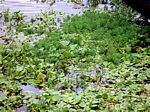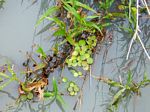Note 19: Amazon frogbit - an update (October 2010) by Mark Hyde
Since the original identification of the species in July 2009, earlier records have come to light and the known range has been extended.
Photo: A view of Limnobium laevigatum, with some E. crassipes (top left). Miller's Creek, Lake Chivero, 2006.
Photo: Limnobium laevigatum and E. crassipes, Miller's Creek, Lake Chivero, 2006. Both species seem to be in their 'pioneer' phase when they are growing rapidly and can disperse easily. Note the swollen petiole in the crassipes plant in the lower right corner, which is typical at this stage.
Photo: Limnobium laevigatum in its early stage (Crocodile Creek, Lake Chivero, December 2009). I (BM) suspect this how the plant normally occurs and the Manyame lakes might be the only place in Africa where it forms mats. The leaves are spongy, in contrast to E. crassipes which has a spongy petiole.
Photo: Limnobium laevigatum in a slightly more advanced state; the leaves are starting to become more upright with longer petioles and the plants are starting to clump together (Lake Chivero, December 2009). Note three early-stage leaves down at the bottom along with early stage E. crassipes (bottom right) and some more advanced plants at the top.
Photo: Limnobium laevigatum (upper left) and E. crassipes (lower right), December 2009. The two species look rather similar to each other at this stage.
In February 2010, Professor Brian Marshall sent to me 5 photographs of an unknown water weed from Lake Chivero, which had been provisionally identified as Eichhornia natans. The plants concerned were in fact Limnobium laevigatum.
The 5 photographs, together with notes supplied by Professor Marshall are reproduced above; 2 were taken at Miller's Creek, Lake Chivero in 2006 and three at Crocodile Creek, Lake Chivero in December 2009.
Of particular interest is that Professor Marshall first recorded this plant in Lake Chivero in 2005, which therefore extends backwards the earliest known date for this species by 4 years.
They also suggest that L. laevigatum is widespread in Lake Chivero and does not only occur near to the Jacana Yacht Club.
Furthermore, Professor Marshall noted that the plant was also common in Lake Manyame and Seke Dam.
On 20 June 2010, the Tree Society found the species to be very common at the edge of Harava Dam, south of Harare.
To summarise these developments, L. laevigatum was first recorded in Zimbabwe in 2005 and appears to be frequent in 4 dams near to Harare, namely Lake Chivero, Lake Manyame and Seke and Harava Dams.




